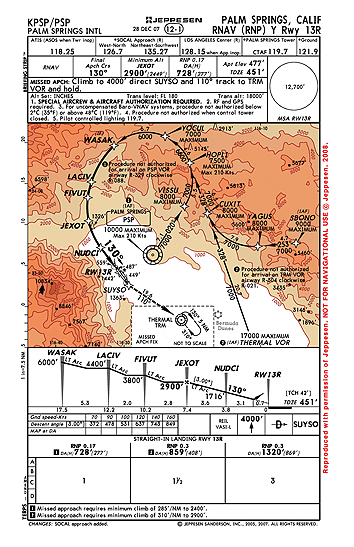
INDUSTRY'S PBN STRATEGY
Boeing has helped shape the evolving PBN standards through close and ongoing involvement with the FAA and ICAO. Boeing has also worked with the Air Traffic Alliance with a goal of developing a strategy that a large number of industry participants can support to establish a clear, focused direction for the future.
In developing a strategy for PBN, Boeing started by observing industry developments, taking into account the trends and constraints of the various regions and technologies, and accommodating the business realities of the airlines and service providers.
All Boeing commercial airplanes manufactured since the 1980s include RNAV capabilities. Boeing began implementing RNP on airplanes in 1994. As of 2000, every Boeing commercial airplane included RNP capability (see fig. 6).
Figure 6

|
CONSIDERATIONS FOR AIRLINE OPERATIONS
PBN is expected to be the foundation for a number of operational changes, including additional point-to-point routes, independent parallel runway operations, and coordinated departures and arrivals for adjacent airports. The degree of impact to requirements for crews, flight operations, maintenance, and dispatch could range from minimal to significant, depending on the current state of airports serviced and associated operating requirements.
Operators moving to PBN should begin coordination with their regulatory agency as soon as possible. When planning additions or modifications to a fleet, operators should carefully consider including RNP-related features such as navigation performance scales, a display feature that integrates lateral navigation and vertical navigation with actual navigation performance and RNP. Operators should also provide as much information as possible about PBN to their operations departments and crews, develop training curriculum and scenarios, and review standard crew procedures.
Operators should fully understand the capabilities of each airplane and match present and future capabilities to what they hope to achieve with PBN operations. For example, one airline took advantage of the improved access afforded by RNP to avoid more than 980 diversions at one airport in 2006. Another airline replaced a non-precision approach into a valley surrounded by mountainous terrain with an RNP “Special Aircraft and Aircrew Authorization Required” (SAAAR) approach. The new approach enhanced safety with a guided, stabilized three-dimensional path to the runway, lowering the landing minima by 1,600 feet and two miles visibility (see fig. 7).
Figure 7
 |
Boeing provides service letters, airplane flight manuals, and other documentation to assist operators in implementing PBN operations. Boeing also offers support information for PBN operations to assist operators seeking approvals by regulators or air navigation service providers, as well as implementation guidance (see sidebar). Also, Boeing subsidiary Jeppesen has begun to expand its RNP services to include FAA AC90-101 Readiness and Application Consulting Services, RNP NavData and Charting, RNP Training, and RNP Monitoring Tools in addition to its current offering of RNP Procedure Development.
Operators should be aware that the operational approvals can range from requiring relatively little effort (i.e., RNAV) to demanding a great deal of time and extremely complex information (i.e., RNP SAAAR).
As PBN continues to evolve, operators have the opportunity to provide input and raise issues and concerns to ICAO and other governing bodies.

